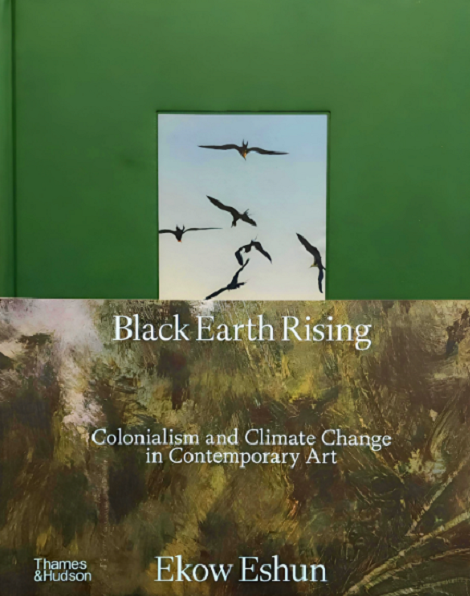
In this article— “At Baltimore Museum of Art, a new exhibition asks us to consider the connections between race, colonialism and the climate crisis”— Louisa Buck (The Art Newspaper) reviews the group exhibition “Black Earth Rising” writes “‘Black Earth Rising’ is a reminder that the climate catastrophe is often felt most keenly by the populations who bare least responsibility for it.” Curated by Ekow Eshun, “Black Earth Rising” is on view at the Baltimore Museum of Art (located at 10 Art Museum Drive, Baltimore, Maryland) until September 21, 2025.
Buck points out that the artists represent an intergenerational group that ranges from British Guianan artist Frank Bowling to younger artists such as Cuban-born Alejandro Piñeiro Bello and Dominican American Firelei Baez… Teresita Fernández (Miami, Florida) and Barbados-born Alberta Whittle are also on the list. [We are still trying to find other Caribbean-rooted artists in this lineup. Feel free to help us!]
The corresponding catalog (shown above) — Black Earth Rising: Colonialism and Climate Change in Contemporary Art (Thames & Hudson) is now available.
It is now an established fact that colonial violence and extraction are crucial factors in the ecological breakdown and climate catastrophe that are currently affecting us all; and that racial justice and climate justice cannot—and should not—be separated.
The connections between race, the climate crisis and colonialism and the part played by empire building in the current plight of the planet are all key themes that run through Black Earth Rising, an exhibition at Baltimore Museum of Art organised by the British curator and writer Ekow Eshun, who has also written the accompanying book. Both book and show aim to pivot environmental debates away from the Northern hemisphere and a Eurocentric viewpoint and to highlight how this catastrophe and its consequences continue to be experienced most keenly by the populations who were rarely responsible for the crisis in the first place.
“Exhibitions or events around ecological crisis and environmental change are often predicated on experiences in the Northern Hemisphere, so we think about polar ice caps and forlorn polar bears when actually the human experience of climate change is experienced predominantly by people in the Global South,” says Eshun. The curator goes on to point out that “while the industrialised nations of the Global North are responsible for 92% of all excess global emissions, it is the poorer nations of the Global South who disproportionately bear the brunt of environmental degradation”.
“Plantationocene”
Eshun takes particular exception with our fixation on the term Anthropocene—used to define the period dating from around 1950 when it is claimed that human activity began to have a direct and dramatic impact on the earth’s geology and ecosystems. The phrase fails to take into account the fact that, for many peoples, the so-called Anthropocene epoch is simply continuing patterns of environmental destruction that began with 15th century European colonisation. Instead, Eshun prefers the notion of the “Plantationocene”, which foregrounds the historical connections and continued impact of colonialism, slavery and the plantation system and traces the roots of the climate crisis back by several centuries to the vast agricultural estates that characterised the European annexation of the New World.
With the plantation system came large-scale land clearing and extensive deforestation. Eshun also notes that, beyond its physical devastation of local ecosystems, the plantation was a system of power and control that triggered the mass migration and displacement of peoples and the establishment of global networks of goods. “Centuries after its development, the plantation continues to shape a modern world based on the extraction of natural resources and radical economic and social inequalities between the Global North and South. We live in its shadow still,” he states.
An intergenerational line up
The exhibition Black Earth Rising brings together thirteen African diasporic, Latin American and Indigenous origin native American artists who Eshun describes as “artists whose origins lie culturally and genealogically within the Global South or within communities of colour”. This intergenerational lineup includes nonagenarian British Guianan artist Frank Bowling, the late Native American artist and curator Jaune Quick-to-See Smith and British Nigerian artist Yinka Shonibare. They are joined by Kenyan American Wangechi Mutu, along with younger artists such as Cuban born, Miami-based Alejandro Piñeiro Bello; Dominican Republic born, New York based Firelei Baez; and the Brooklyn based photographer Tyler Mitchell.
Whether in painting, sculpture, textiles, film or photography all the artists in Black Earth Rising are dedicated to exploring questions of history, power, climate change, and social and environmental justice. But rather than being finger-waggingly didactic, they do so in ways that also emphasise the poetic, the lyrical, the sensory and often the sheer beauty of the natural world. [. . .]
For full review, go to https://www.theartnewspaper.com/2025/07/02/at-baltimore-museum-of-art-a-new-exhibition-asks-us-to-consider-the-connections-between-race-colonialism-and-the-climate-crisis
For catalog information, see https://artbma.org/exhibition/black-earth-rising/catalogue
[Photo above by Meg Rorison.]
In this article— “At Baltimore Museum of Art, a new exhibition asks us to consider the connections between race, colonialism and the climate crisis”— Louisa Buck (The Art Newspaper) reviews the group exhibition “Black Earth Rising” writes “‘Black Earth Rising’ is a reminder that the climate catastrophe is often felt most keenly by the populations
